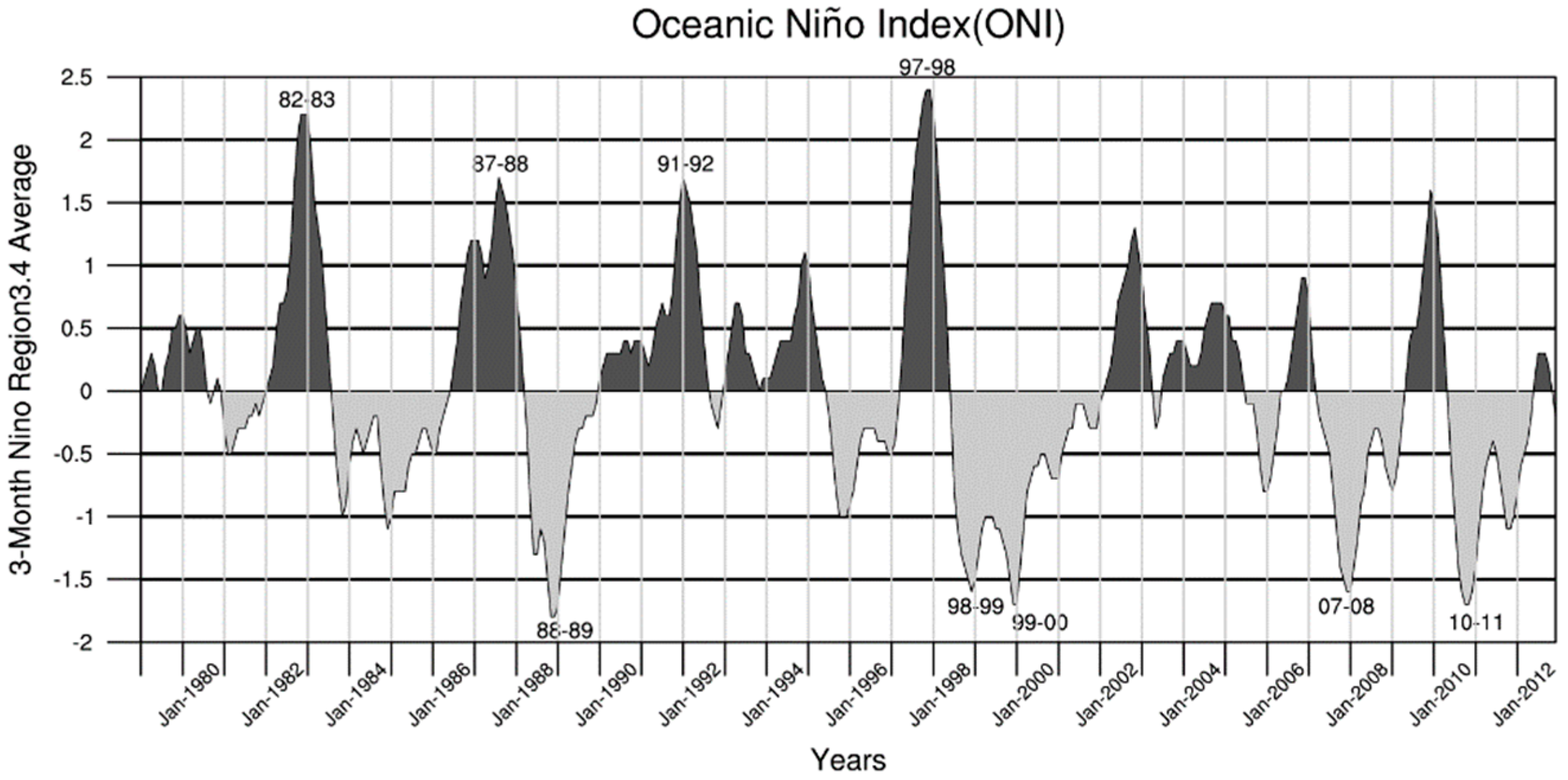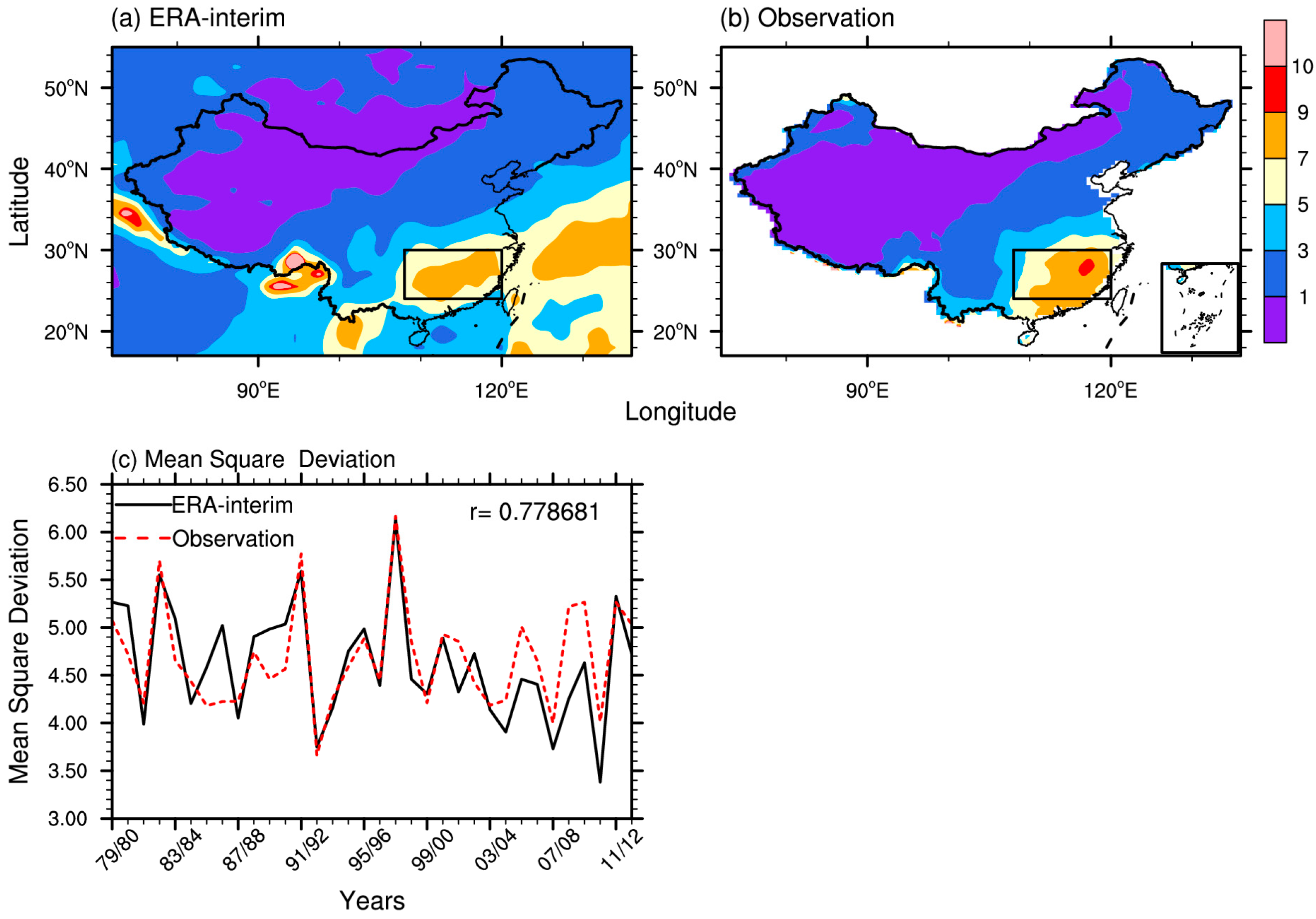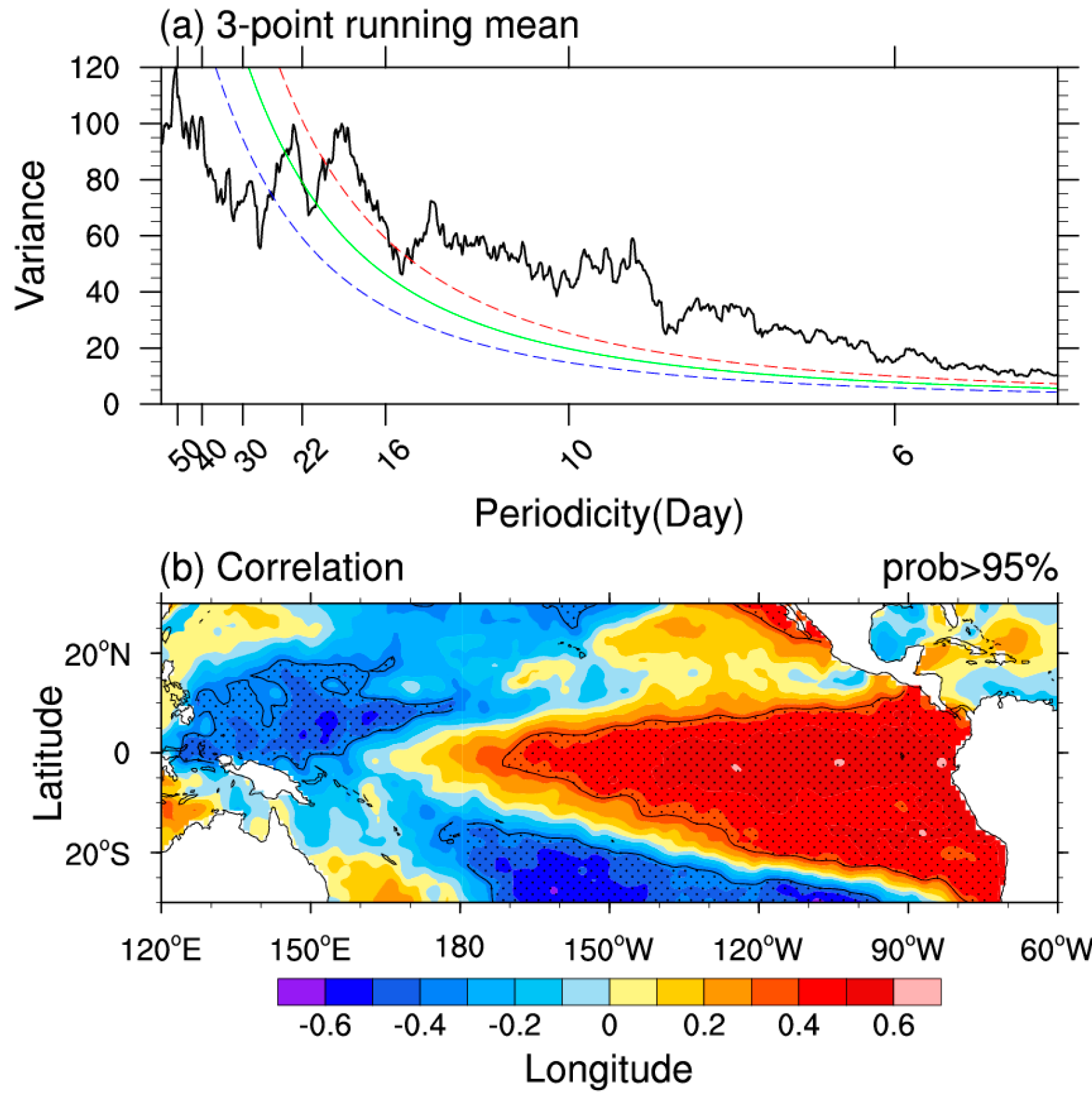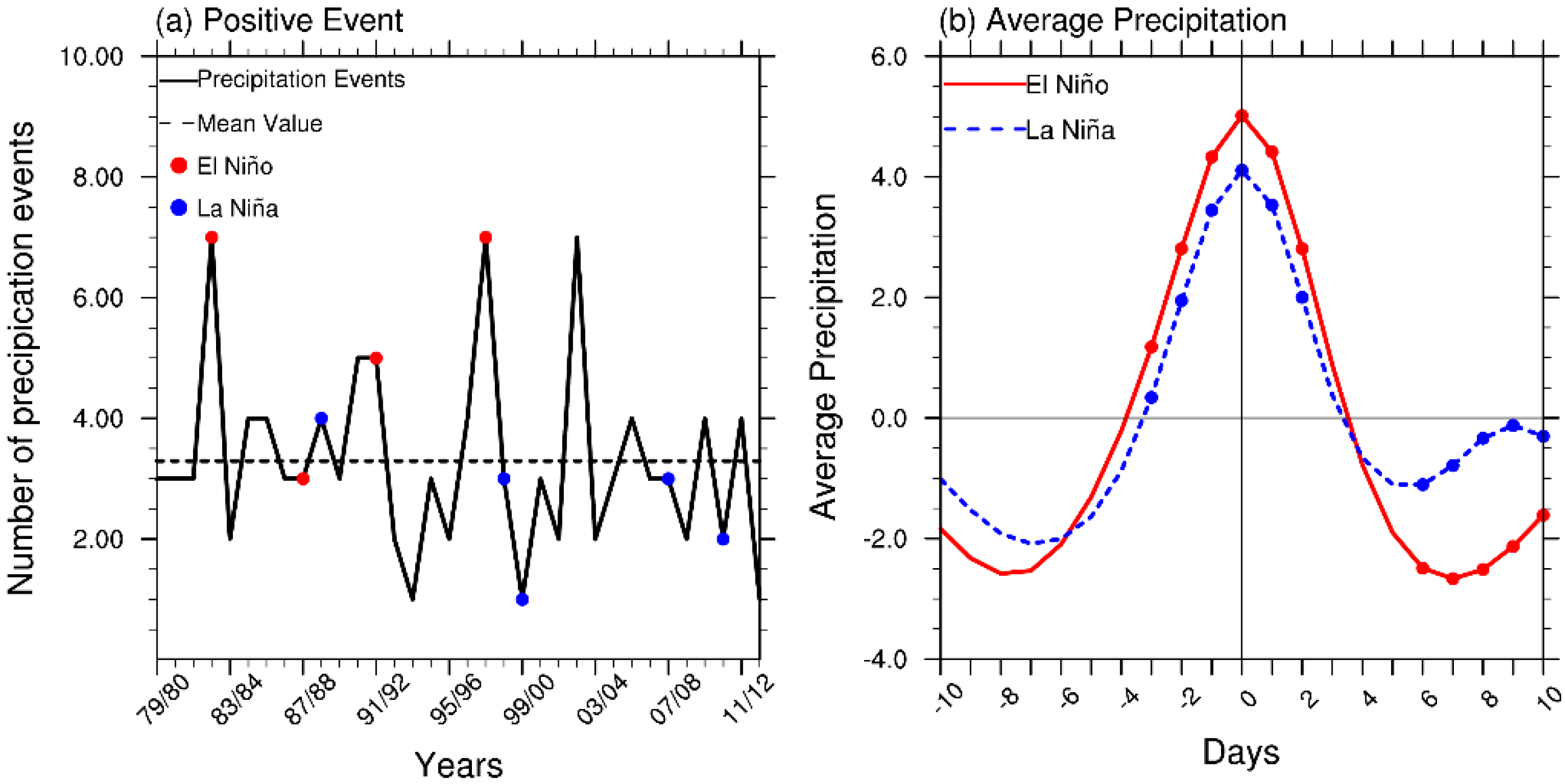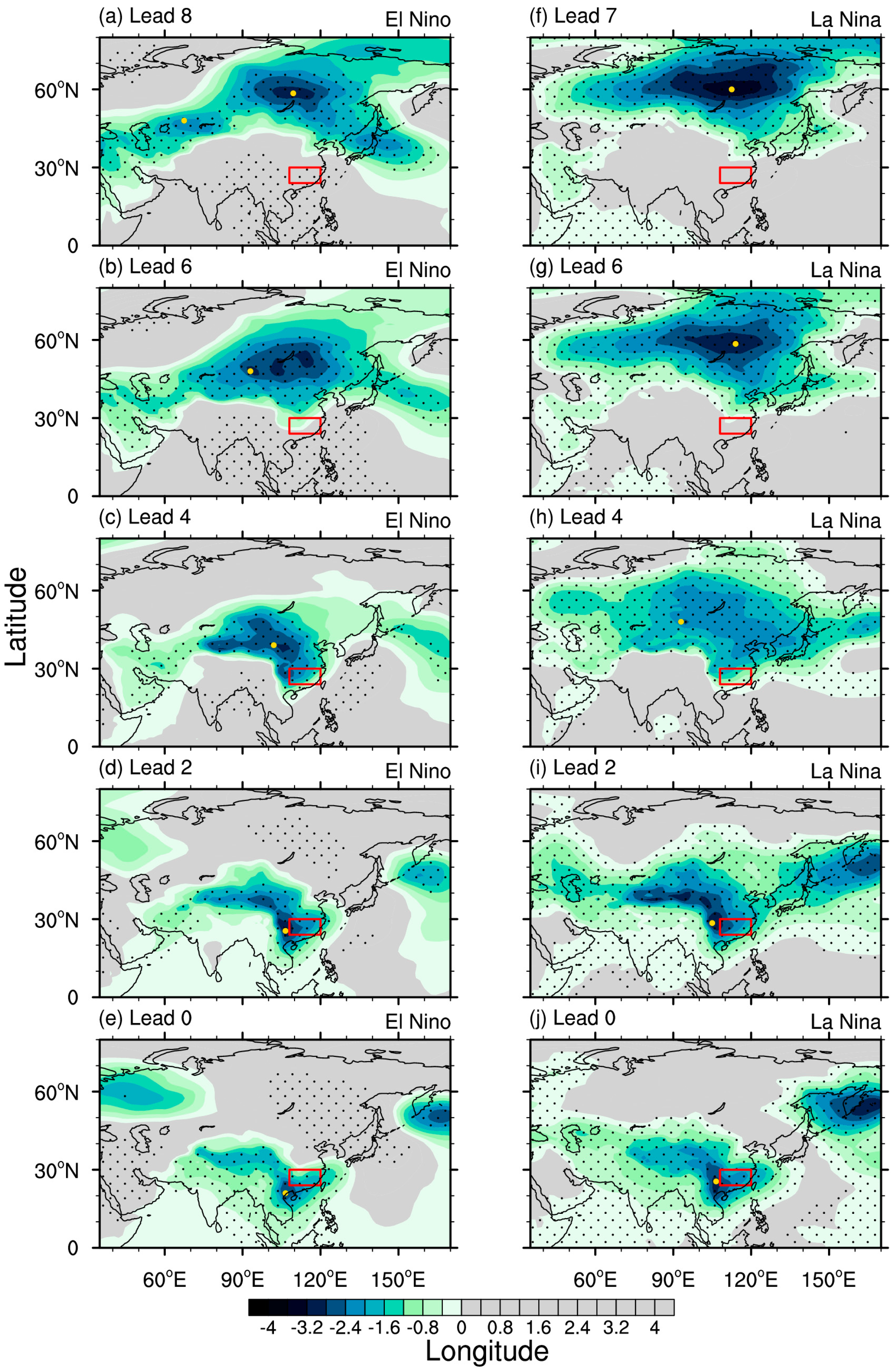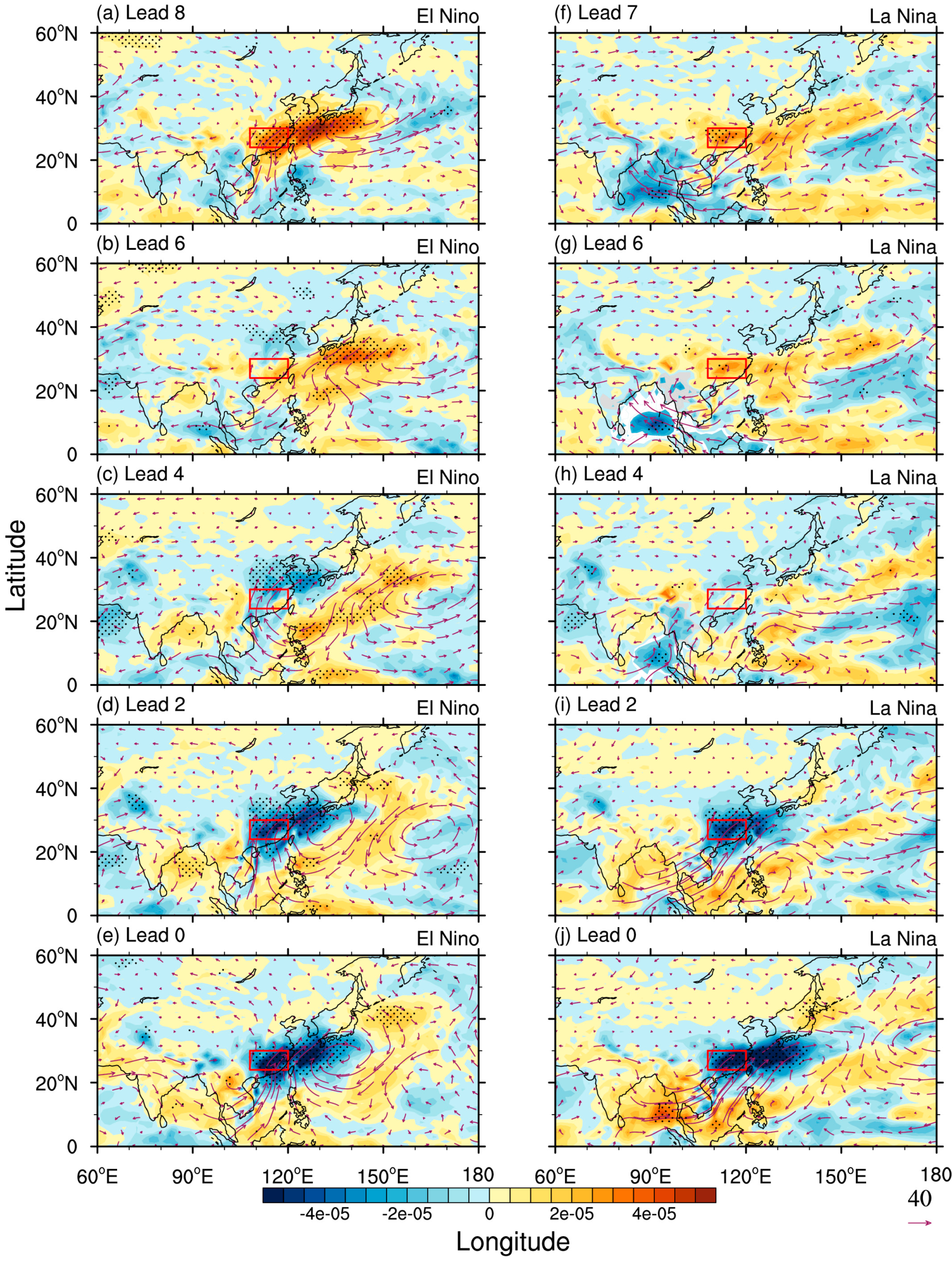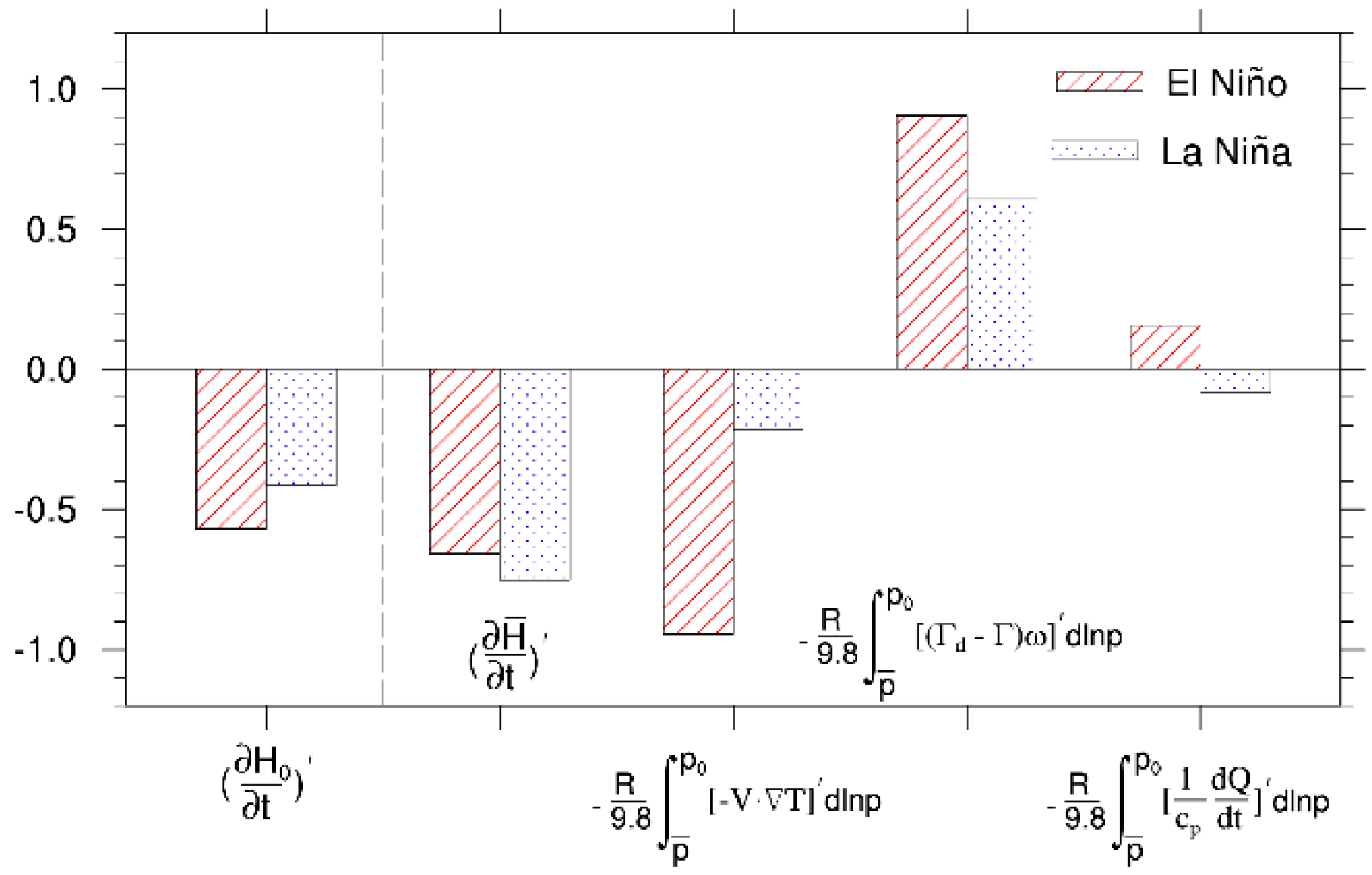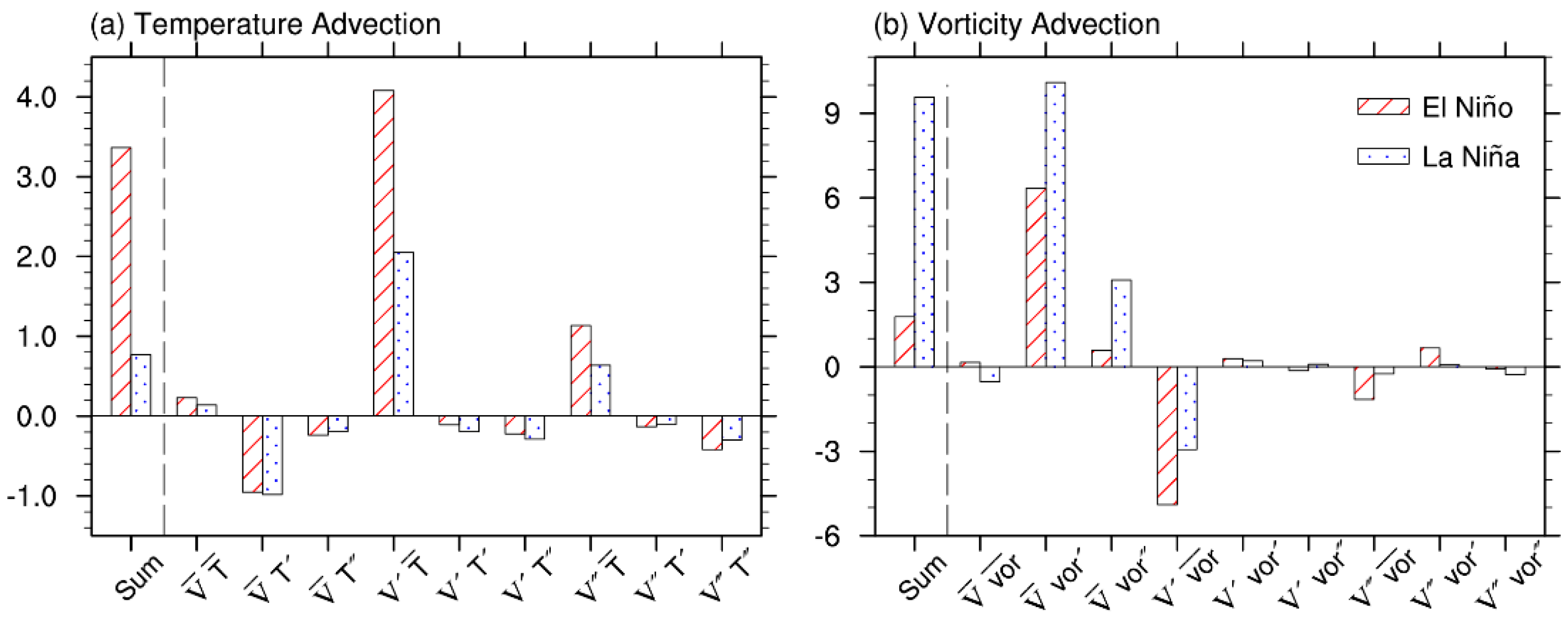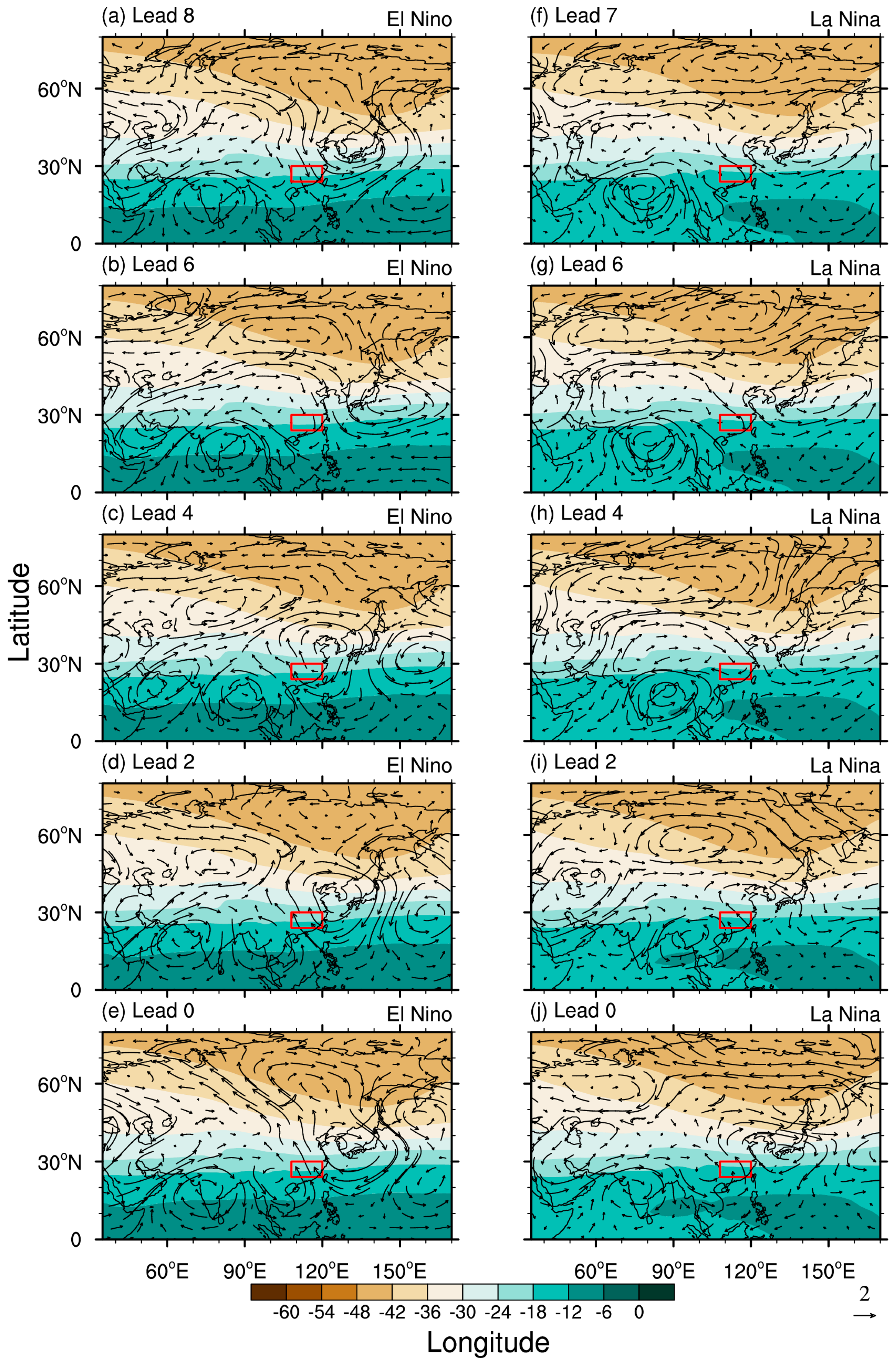2. Data and Methods
The present study uses the ECMWF ERA-interim reanalysis [
30] data that provides daily precipitation and other routine meteorological data, such as geopotential height, zonal and meridional winds, temperature, and vertical integral of vapor flux, etc. The ERA dataset is on
grids from 1979 to present. The SST over the tropical Pacific is based on the Hadley Centre sea ice and sea surface temperature data (HadISST) [
31] with a horizontal resolution of 1°. Other daily precipitation data are derived from 756 observation stations in China.
In this study, the boreal winter refers to the months from November to the following April (NDJFMA). The number of total days of the 34 winters (from 1979/1980 to 2012/2013) is 6163.
El Niño (La Niña) is a phenomenon in the equatorial Pacific Ocean characterized by five consecutive 3-month running mean sea surface temperature (SST) anomalies in the Niño 3.4 region (5° S–5° N, 120° W–170° W) that is above (below) the threshold of +0.5 °C (−0.5 °C). This standard is known as the Oceanic Niño Index (ONI), which can be found at
http://origin.cpc.ncep.noaa.gov/products/analysis_monitoring/ensostuff/ONI_v5.php). In this case, strong ENSO events have been analyzed. The strong El Niño (La Niña) years also need to meet a minimum of 3 consecutive overlapping seasons at or above (below) the +1.5 °C (−1.5 °C) anomaly. Under this rule, four El Niño winters (1982/83, 1987/88, 1991/92, 1997/98) and five La Niña winters (1988/89, 1998/99, 1999/00, 2007/08, 2010/11) are identified, shown in
Figure 1.
To diagnosis the development of surface system, the Equation of surface forecast is used.
where
is surface pressure,
is the pressure in an average layer (500 hPa in this paper),
t is time,
is the geopotential of
,
V is the zonal and meridional wind,
T is the air temperature,
is the adiabatic lapse rate,
ω is the vertical velocity, and
Q is the diabatic heating. The constant coefficients include the specific gas constant
, the specific heat at constant pressure
and adiabatic rate
. For the following discussion, the left side of the equation present the geopotential tendency at 1000 hPa, expressed by Ht1000. The first item on the right side of the equation is the geopotential tendency at 500 hPa, expressed by Ht500. The second item on the right side is temperature advection. The third item is adiabatic heating (the vertical transportation of potential temperature). The fourth item is diabatic heating. Prime presents the intraseasonal time scale (10–30 day filtered).
Based on the definition of time scale, multiscale analysis is applied to separate the key items in Equation (1) so as to discuss the interaction between different time scale components. Every variable (
) is divided into three parts:
, where
presents the background field (>30 day),
is the intraseasonal field (10–30 day) and
is the synoptic-scale field (<10 day). The M-term Guassian-Type filter is used to get the background field. The Butterworth filter is used to get the intraseasonal and synoptic disturbance, with the windows 10–30 days and 3–10 days respectively. In this case, the wind and the temperature can be written as:
And the vertically integrated temperature advection
can be written as:
The geopotential tendency at 500 hPa is mainly determined by the relative vorticity advection, geostrophic vorticity advection, the tilting term, and the divergence term. As for the mid-latitude systems (for a shortwave system), the relative vorticity advection is very important [
32]. To analyze the geopotential tendency at 500 hPa, the relative vorticity advection
must be analyzed, which is evaluated in the same way. The intraseasonal relative vorticity advection can be separated as the following:
3. Results
The variation in precipitation intensity for 34 winters, as indicated by the mean square deviation of daily precipitation, is shown in
Figure 2. Comparing the results of ERA-interim precipitation (
Figure 2a) with observation precipitation (
Figure 2b), the mean square deviations have similar distributions and level of quantity. Both results present the degressive trend from southeast to northwest. The maximum activity extends northeastward, mainly covering southern China (approximately 24° N–30° N, 108° E–120° E). The annual mean square deviation of ERA-interim precipitation in southern China is close in accord with that of observation precipitation with a correlation coefficient of 0.77. The high consistency between the ERA-interim precipitation results and the observation results proves the ERA-interim precipitation is credible. Considering the possibility of rain belt moving to sea, ERA-interim precipitation is more favorable since there are no observed data over the ocean. Therefore, ERA-interim precipitation data are used below.
To obtain the significant cycle of winter precipitation over southern China, a power spectrum was used to analyze the dominant period of the winter precipitation. As indicated in
Figure 3a, the red noise test shows that the cycle from 10 to 30 days is dominant at the intraseasonal time scale (10–90 day). Therefore, the original precipitation data were filtered on 10–30 day time scales by the Butterworth bandpass filter to highlight the 10–30 day oscillation variations. Ten to thirty day filtering was also carried out for other conventional element fields. Based on that, the correlation relationship between the mean square deviation of 10–30 day filtered winter precipitation in southern China and the raw winter SST is shown in
Figure 3b. The correlations are high and significant in the central and eastern tropical Pacific region. This indicates that the 10–30 day precipitation oscillation intensity over southern China is strong (weak) when the SST anomaly is positive (negative) in the central and eastern tropical Pacific.
To detect possible impacts of ENSO on the intraseasonal evolution of the precipitation in winter,
Figure 4 shows the frequency of the precipitation 10–30 day oscillation events and the evolution of the 10–30 day filtered precipitation in ENSO years. The study of precipitation could be carried out by extracting the active phase of 10–30 day precipitation, which means the intraseasonal precipitation events. On the basis of the regional average, a peak value greater than 1.5 times the mean square deviation was selected as one event. Peak times were defined as the 0 days of each event, and the precipitation of the 10–30 day filter with leading and lagging 1–10 day windows was synthesized.
In El Niño winters, precipitation oscillation events over southern China occurred 22 times, with up to seven events in 1982/83 and 1997/98, followed by five in 1992/93. The intraseasonal oscillation events in three out of four El Niño years are substantially higher than the mean value, and in the remaining years it is approximately the same as the mean value (slightly less). In most of the La Niña years, the frequency of the oscillation events is less than the average (
Figure 4a). The intraseasonal precipitation has stronger amplitudes and a longer dominant period during El Niño years than that of La Niña years (
Figure 4b). Basically, regardless of the El Niño year or La Niña year, precipitation has a significant quasi-biweekly oscillation. The dominant period of precipitation during El Niño years is 15 or 16 days, while that during La Niña years is 12 or 13 days. In the following sections, the initial time of precipitation period is scheduled for −8 day (El Niño) and −7 day (La Niña) respectively.
The precipitation belt and its development over southern China are closely related to the low-pressure system activity [
33,
34], as well as the water vapor transport from the ocean [
35,
36,
37]. To diagnose the propagation characteristics of intraseasonal precipitation over southern China, the lead compositions of daily geopotential height and vapor transport from the ERA-interim were studied further (10–30-day filtered,
Figure 5 and
Figure 6).
For El Niño, there are two significant intraseasonal low-pressure systems of geopotential height in the north of Lake Baikal and the east of Aral Sea. From −8 day to −6 day (
Figure 5a,b), the Lake Baikal intraseasonal low-pressure system moves southeastward and then turns southwestward while the Aral Sea intraseasonal low-pressure system extends from west to east along the northern side of the Tianshan Mountains. Both intraseasonal low-pressure systems intensify and join at the Altay Mountains, exhibiting the largest degree of intensity at −6 day. From −6 day to the peak day, the intraseasonal low-pressure system at the Altay Mountains weakens, and its northwest–southeast central tilt continues to move southeastward into southern China.
For La Niña, a strong and significant intraseasonal low-pressure system appears in middle–high latitude of the northern hemisphere. It is located in the Central Siberian Plateau and stretches across much of the north of the supercontinent of Eurasia. In contrast to that observed for El Niño, this low-pressure system is much stronger and more northerly in the initial stage (−7 day,
Figure 5f). Subsequently, the intraseasonal low-pressure system moves steadily from the north to the south while increasing in scope and decreasing in strength. During −4 day, the area range and intensity of the low-pressure system both reach their extreme value before its center moves southeastward into southern China. For both El Niño and La Niña, the intraseasonal rainfall appears in southern China when the intraseasonal low-pressure system moves to 30° N, and southern China is located in the eastern part of the low-pressure system.
In winter, the intraseasonal water vapor flux over southern China is mainly from the middle–low latitude ocean. For El Niño, an intraseasonal north wind appears in South China and mid-latitude Pacific Ocean causing strong divergence of water vapor at the initial time (−8 day,
Figure 6a). When the cyclonic type circulation of vapor transport moves eastward, the divergence center decreases significantly with a corresponding movement, and water vapor rapidly shifts to convergence in southern China. At −4 day (
Figure 6c), the coastal areas appear to have a strong anticyclonic circulation of water vapor flux and be controlled by weak water vapor convergence. Subsequently, the anticyclonic circulation moves eastward with range reducing gradually where strong vapor transports from the Bay of Bengal, the South China Sea into southern China. A large amount of water vapor both from low latitudes and northwestern Pacific is concentrated in southern China providing sufficient vapor conditions for precipitation.
For La Niña, the water vapor transportation (10–30 day filtered) over southern China mostly comes from coastline causing two significant opposite water vapor centers located in southern China and the Bay of Bengal, respectively. At −7 day (
Figure 6f), the water vapor exhibits relatively less divergence over southern China and stronger convergence in Bay of Bengal, respectively, by the northeast vapor transportation near South China Sea (SCS) to Indo-China Peninsula. Afterwards, the cyclonic circulation vapor transportation first weakens and shifts to anticyclonic at −4 day, then the center of vapor flux divergence field changes into convergence over southern China and divergence in Bay of Bengal at −2 day. This condition of water vapor is maintained for two days and reaches its peak at 0 day which provides a suitable vapor environment for precipitation.
Quantitative analysis of vapor flux divergence during the precipitation active period (−3 day to 3 day) can be used to reflect the difference of intensity of intraseasonal precipitation between El Niño and La Niña. The results indicate that the mean vapor flux divergence over South China in El Niño (−2.84922 ×
) is larger than that in La Niña (−2.692329 ×
), which are in accordance with the results of
Figure 4b.
Utilizing the equation of surface forecast (Equation (1)), the low-pressure system at 1000 hPa that influences winter precipitation was theoretically analyzed. Because of low-pressure system is always moving in the direction of the pressure tendency gradient, selecting its central position of lagging 1 d as the key point of each day, the 10–30 day filtered geopotential height tendency was studied. As indicated in
Figure 4b, the initial time of precipitation in El Niño and La Niña years is different, the whole leading period of precipitation is set from −8 day to the 0 day (El Niño) and −7 day to the 0 day (La Niña). Owing to the need to extract data from the day ahead, the study of the surface forecast equation was mainly in −8 day to −1 day (El Niño) and −7 day to −1 day (La Niña). The average of these days is called the averaging process below.
On the whole, as the intensity of the 1000 hPa low-pressure system gradually strengthened,
is always negative. If the result of right items in Equation (1) is also negative, then this item has positive contribution to low-pressure system development. Conversely, positive value is expressed as negative contribution that impedes development. The various terms in the surface forecast equation have made different contributions to the evolution of the 1000 hPa low-pressure system, as shown in
Figure 7.
For El Niño, temperature advection has largest positive contribution rate, the effect of geopotential tendency over 500 hPa (Ht500) is smaller than the former, and the others are opposed. The balance between equation terms indicates that the low-pressure system is mainly caused by the joint effects of the Ht500 and the temperature advection. For La Niña, geopotential tendency over 500 hPa (Ht500) accounts for the dominant status as the effect of other items is weak throughout. Furthermore, with the occurrence of precipitation, the adiabatic heating presents a significant negative contribution, and the diabatic heating transforms into positive contribution in both El Niño and La Niña (Figure omitted).
The temperature advection and geopotential tendency at 500 hPa are responsible for the strength of the intraseasonal low-pressure system. For the middle latitudes, the geopotential tendency at 500 hPa is mainly determined by the relative vorticity advection (for a shortwave system), therefore, the multiscale analysis of vertically integrated temperature advection from the surface to 500 hPa
and vorticity advection over 500 hPa
in the averaging process (El Niño from −8 day to −1 day; La Niña from −7 day to −1 day) are shown in
Figure 8.
For temperature advection, warm advection in El Niño is noticeably more than that in La Niña. The contribution to the warm advection from the intraseasonal wind when the background temperature is the maximum, and the one from synoptic-scale wind when the background temperature is of secondary importance, indicated background temperature plays a major role in the intraseasonal low-pressure system motion both in El Niño and La Niña. For relative vorticity advection over 500 hPa, positive vorticity advection in El Niño is less than that in La Niña. The interaction between background wind and intraseasonal vorticity and that between background wind and the synoptic-scale vorticity are two major factors impacting on the structure and motion of intraseasonal low-pressure system in La Niña.
To illustrate more clearly the propagation of warm advection and vorticity advection, the greatest contribution of them based on multiscale analysis was studied further.
Figure 9 shows the intraseasonal wind and the background temperature over 500 hPa, which are most vulnerable to the temperature advection. During the precipitation oscillation period, the distribution of the background temperature is roughly the same both in El Niño and La Niña, appearing as descending from the equator to the North Pole and a cold trough situated in Okhotsk Sea.
However, the spatial distribution of the intraseasonal circulation fields is quite different. For El Niño, the longitudinal distribution of intraseasonal circulation is conspicuous, and the spatial distribution is very zonally asymmetrical. At −8 day, an intraseasonal cyclonic gyre extends northwestward from the Central Siberian Plateau to the Sea of Japan with the center in the Sea of Japan, another cyclonic gyre appears in the Aral Sea, and an anti-cyclonic gyre dominates in the middle. At low latitudes, an anticyclone gyre hovers over the Indian peninsula continuing to move eastward into the Indo–China Peninsula. At −4 day, those two cyclonic gyres in the middle–high latitudes gradually close together and even merge and move southwestward while anti-cyclonic gyre moves southward into the Pacific. At the same time of precipitation, the circulation of intraseasonal wind becomes opposite to the initial, but within similar geographical locations.
For La Niña, the intraseasonal circulation has a zonal distribution which is different from that in El Niño. At −7 day, Russia is dominated by a huge cyclonic gyre, and the west wind is quite remarkable near 60° N, and an anti-cyclonic gyre persists in its southern part. During the precipitation oscillation period, the cyclonic gyre moves southward stably and continuously until it controls most of Asia, which indicates weaker temperature tendency.
In comparison, the intraseasonal wind in El Niño features a zonal inhomogeneous structure as shown in
Figure 9a–e. Temperature advection features a southwest–northeast distribution, leading to stronger warm advection in the east of intraseasonal cyclone gyre and brings significant temperature advection in El Niño, which differs from that in La Niña.
The interaction of intraseasonal vorticity and background wind are the biggest contributions to the vorticity advection. Similar to the background temperature, the distribution of background wind also has no variety during both El Niño and La Niña. Essentially, westerly winds prevail in the north of the subtropics with a stationary cyclonic circulation. The intraseasonal vorticity is largely determined by intraseasonal wind, which manifests as a meridional structure in El Niño and a zonal pattern in La Niña (
Figure 10). The intraseasonal winds and vorticity at 500 hPa are consistent with the 1000 hPa intraseasonal low-pressure system. The zonal distribution of the intraseasonal vorticity and the background meridional wind behind the East Asia trough, bring positive vorticity advection and lead to 1000 hPa intraseasonal low-pressure system to move southward.
